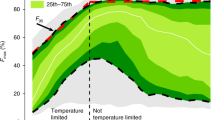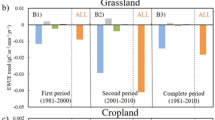Abstract
Land use practices have replaced much of the natural needleleaf evergreen, broadleaf deciduous, and mixed forests of the Eastern United States with crops. To a lesser extent, the natural grasslands in the Central United States have also been replaced with crops. Simulations with a land surface process model coupled to an atmospheric general circulation model show that the climate of the United States with modern vegetation is significantly different from that with natural vegetation. Three important climate signals caused by modern vegetation are: (1) 1 °C cooling over the Eastern United States and 1 °C warming over the Western United States in spring; (2) summer cooling of up to 2 °C over a wide region of the Central United States; and (3) moistening of the near-surface atmosphere by 0.5 to 1.5 g kg-1over much of the United States in spring and summer. Although individual months show large, statistically significant differences in precipitation due to land-use practices, these differences average out over the course of the 3-month seasons. These changes in surface temperature and moisture extend well into the atmosphere, up to 500 mb, and affect the boundary layer and atmospheric circulation. The altered climate is due to reduced surface roughness, reduced leaf and stem area index, reduced stomatal resistance, and increased surface albedo with modern vegetation compared to natural vegetation. The climate change caused by land use practices is comparable to other well known anthropogenic climate forcings. For example, it would take 100 to 175 years at the current, observed rate of summer warming over the United States to offset the cooling from deforestation. The summer sulfate aerosol forcing completely offsets the greenhouse forcing over the Eastern United States. Similarly, the climatic effect of North American deforestation, with extensive summer cooling, further offsets the greenhouse forcing.
Similar content being viewed by others
References
Bonan, G. B.: 1995a, ‘Land-Atmosphere CO2 Exchange Simulated by a Land Surface Process Model Coupled to an Atmospheric General Circulation Model’, J. Geophys. Res. 100, 2817–2831.
Bonan, G. B.: 1995b, ‘Sensitivity of a GCM Simulation to Inclusion of Inland Water Surfaces’, J. Clim. 8, 2691–2704.
Bonan, G. B.: 1996a, A Land Surface Model (LSM Version 1.0) for Ecological, Hydrological, and Atmospheric Studies: Technical Description and User's Guide, NCAR Tech. Note NCAR/TN-417+STR. Nat. Center for Atmos. Res., Boulder, CO, p. 150.
Bonan, G. B.: 1996b, The NCAR Land Surface Model (LSM Version 1.0) Coupled to the NCAR Community Climate Model, NCAR Tech. Note NCAR/TN-429+STR, Nat. Center for Atmos. Res., Boulder, CO, p. 171.
Bonan, G. B.: 1996c, ‘Sensitivity of a GCM Simulation to Subgrid Infiltration and Surface Runoff’, Climate Dynamics 12, 279–285.
Bonan, G. B., Pollard, D., and Thompson, S. L.: 1992, ‘Effects of Boreal Forest Vegetation on Global Climate’, Nature 359, 716–718.
Bonan, G. B., Chapin, F. S. III, and Thompson, S. L.: 1995, ‘Boreal Forest and Tundra Ecosystems as Components of the Climate System’, Clim. Change 29, 145–167.
Charney, J., Quirk, W. J., Chow, S-H., and Kornfeld, J.: 1977, ‘A Comparative Study of the Effects of Albedo Change on Drought in Semi-Arid Regions’, J. Atmos. Sci. 34, 1366–1385.
Chervin, R. M. and Schneider, S. H.: 1976a, ‘A Study of the Response of NCAR GCM Climatological Statistics to Random Perturbations: Estimating Noise Levels’, J. Atmos. Sci. 33, 391–404.
Chervin, R. M. and Schneider, S. H.: 1976b, ‘On Determining the Statistical Significance of Climate Experiments with General Circulation Models’, J. Atmos. Sci. 33, 405–412.
Chervin, R. M., Washington, W. M., and Schneider, S. H.: 1976, ‘Testing the Statistical Significance of the Response of the NCAR General Circulation Model to North Pacific Ocean Surface Temperature Anomalies’, J. Atmos. Sci. 33, 413–423.
Copeland, J. H., Pielke, R. A., and Kittel, T. G. F.: 1996, ‘Potential Climate Impacts of Vegetation Change: A Regional Modeling Study’, J. Geophys. Res. 101, 7409–7418.
Espenshade, E. B. Jr. and Morrison, J. L.: 1990, Goode's World Atlas 18th Edition, Rand McNally, Chicago, p. 368.
Feldman, T. S.: 1992, ‘Climate and History in the Late 18th and Early 19th Centuries’, EOS, Trans. Amer. Geophys. Union 73, 1.
Foley, J. A., Kutzbach, J. E., Coe, M. T. and Levis, S.: 1994, ‘Feedbacks between Climate and Boreal Forests during the Holocene Epoch’, Nature 371, 52–54.
Glantz, M. H.: 1994, Drought Follows the Plow: Cultivating Marginal Areas, Cambridge University Press, Cambridge, p. 232.
Hack, J. J., Boville, B. A., Briegleb, B. P., Kiehl, J. T., Rasch, P. J., and Williamson, D. L.: 1993, Description of the NCAR Community Climate Model (CCM2), NCAR Tech. Note NCAR/TN-382+STR, Nat. Center for Atmos. Res., Boulder, CO, p. 108.
Hansen, J., Sato, M., and Ruedy, R.: 1995, ‘Long-Term Changes of the Diurnal Temperature Cycle: Implications about Mechanisms of Global Climate Change’, Atmos. Res. 37, 175–209.
Henderson-Sellers, A., Dickinson, R. E., Durbidge, T. B., Kennedy, P. J., McGuffie, K., and Pitman, A. J.: 1993, ‘Tropical Deforestation: Modeling Local-to Regional-Scale Climate Change’, J. Geophys. Res. 98, 7289–7315.
Karl, T. R., Jones, P. D., Knight, R. W., Kukla, G., Plummer, N., Razuvayev, V., Gallo, K. P., Lindseay, J., Charlson, R. J., and Peterson, T. C.: 1993, ‘Asymmetric Trends of Daily Maximum and Minimum Temperature’, Bull. Amer. Met. Soc. 74, 1007–1023.
Kiehl, J. T. and Briegleb, B. P.: 1993, ‘The Relative Roles of Sulfate Aerosols and Greenhouse Gases in Climate Forcing’, Science 260, 311–314.
Kiehl, J. T. and Rodhe, H.: 1995, ‘Modeling Geographical and Seasonal Forcing Due to Aerosols’, in: Charlson, R. J. and Heintzenberg, J. (eds.), Aerosol Forcing of Climate, John Wiley and Sons, New York, pp. 281–296.
Kiehl, J. T., Hack, J. J., Bonan, G. B., Boville, B. A., Briegleb, B. P., Williamson, D. L., and Rash, P. J.: 1996, Description of the NCAR Community Climate Model (CCM3), NCAR Tech. Note NCAR/TN-420+STR, Nat. Center for Atmos. Res., Boulder, CO, p. 152.
Kutzbach, J., Bonan, G., Foley, J., and Harrison, S. P.: 1996, ‘Vegetation and Soil Feedbacks on the Response of the African Monsoon to Orbital Forcing in the Early to Middle Holocene’, Nature 384, 623–626.
Laval, K. and Picon, L.: 1986, ‘Effect of a Change of the Surface Albedo of the Sahel on Climate’, J. Atmos. Sci. 43, 2418–2429.
Legates, D. R. and Willmott, C. J.: 1990a, ‘Mean Seasonal and Spatial Variability in Global Surface Air Temperature’, Theor. Appl. Climatol. 41, 11–21.
Legates, D. R. and Willmott, C. J.: 1990b, ‘Mean Seasonal and Spatial Variability in Gauge-Corrected, Global Precipitation’, Int. J. Climatol. 10, 111–127.
McGuffie, K., Henderson-Sellers, A., Zhang, H., Durbidge, T. B., and Pitman, A. J.: 1995, ‘Global Climate Sensitivity to Tropical Deforestation’, Global Planet. Change 10, 97–128.
Olson, J. S., Watts, J. A., and Allison, L. J.: 1983, Carbon in Live Vegetation of Major World Ecosystems, ORNL-5862, Oak Ridge Nat. Lab., Oak Ridge, TN, p. 397.
Pielke, R. A., Lee, T. J., Copeland, J. H., Eastman, J. L., Ziegler, C. L., and Finley, C. A.: 1997, ‘Use of USGS-Provided Data to Improve Weather and Climate Simulations’, Ecol. Appl. 7, 3–21.
Pollard, D. and Thompson, S. L.: 1995, ‘Use of a Land-Surface Transfer Scheme (LSX) in a Global Climate Model: The Response to Doubling Stomatal Resistance’, Global Planet. Change 10, 129–161.
Trenberth, K. E.: 1992, Global Analyses from ECMWF and Atlas of 1000 to 10 mb Circulation Statistics, NCAR Tech. Note NCAR/TN-373+STR, Nat. Center for Atmos. Res., Boulder, CO, p. 191.
Williams, M.: 1989, Americans and Their Forests: A Historical Geography, Cambridge University Press, Cambridge, p. 599.
Xue, Y. and Shukla, J.: 1993, ‘The Influence of Land Surface Properties on Sahel Climate. Part I: Desertification’, J. Clim. 6, 2232–2245.
Xue, Y., Fennessy, M. J., and Sellers, P. J.: 1996, ‘Impact of Vegetation Properties on U.S. Summer Weather Prediction’, J. Geophys. Res. 101, 7419–7430.
Zhang, H., Henderson-Sellers, A., and McGuffie, K.: 1996, ‘Impacts of Tropical Deforestation. Part I: Process Analysis of Local Climatic Change’, J. Clim. 9, 1497–1517.
Author information
Authors and Affiliations
Rights and permissions
About this article
Cite this article
Bonan, G.B. Effects of Land Use on the Climate of the United States. Climatic Change 37, 449–486 (1997). https://doi.org/10.1023/A:1005305708775
Issue Date:
DOI: https://doi.org/10.1023/A:1005305708775




